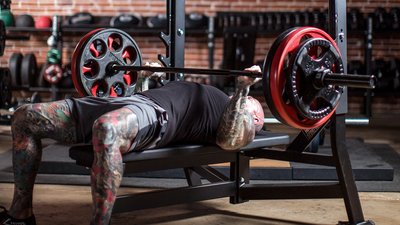Regardless of how experienced a lifter you are, you should be reanalyzing the basics constantly, particularly on staple exercises like the bench press. It's one of the best strength and size builders for the upper body, so doing it correctly is crucial.
One of the biggest misconceptions about the bench press is that it is a "dangerous" exercise. Sure, if you do it improperly, you can get hurt, but you can get hurt crossing the street if you don't pay attention to the crosswalk lights and oncoming traffic.
The bench press is no more dangerous than any other upper-body pressing exercise you do with dumbbells or even a machine. There are ways to do things in a dangerous manner, and there are ways to do them safely.
When it comes to bench pressing for size and strength and without injury, follow the list below, and you'll be positioned to make great upper-body gains, minus the injuries.
The 5 Points of Contact
1. Feet
The first point of contact is your feet on the ground. The next time you train, try to do the exercise with your feet off the ground, resting on the bench. Trust me, you won't be nearly as strong, because not having a solid base beneath will rob you of power and strength, even in the upper body.
The force you produce to press the bar up does not just come from the chest, shoulders, and triceps. Force is distributed throughout the body, moving from your feet through your legs and hips, through the spine, and up to your shoulders and arms.
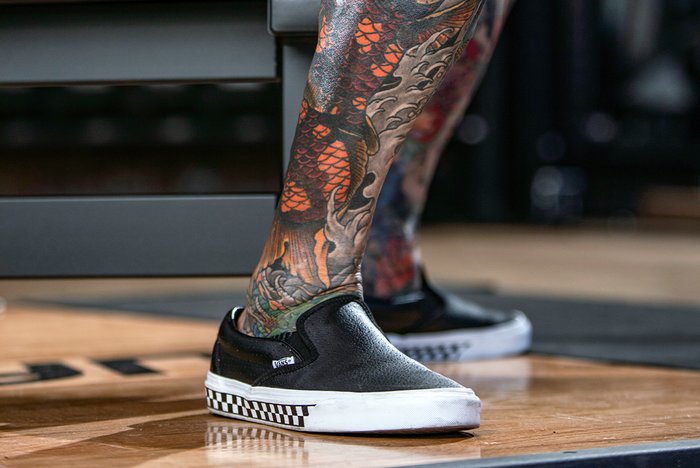
x
Most people say your feet should be flat on the floor, and this advice would seem to make sense for having a solid base. If you really want to maximize your strength and power and push as much weight as possible, however, you need to move your feet back as far as possible, somewhere below your mid-thighs or even your hips, which would mean your heels would be off the floor. Pulling your feet back also helps to create a better arch in the lower back.
Flat versus heels up can also depend on the length of your legs and the height of the bench. If you have long legs or the bench is relatively close to the ground, you'll probably want to keep your heels on the floor.
Point of Contact Take-Home Tip: Tuck in your feet underneath you (as far as is comfortable) toward your hips and shoulders.
2. Glutes
After your feet are set as far back as possible, your next point of contact is the glutes. The key here is simple: Your glutes should be in contact with the bench the entire time, and your lower back should not.
A small arch in your lower back—enough space that someone could slide a hand freely between your lower back and the bench—will not only help protect it but also provide a more stable trunk from which to press, maximizing pressing strength.

You have probably seen powerlifters exaggerate the arch to raise the torso that much more off the bench and create a shorter range of motion, but if you're not doing bench press competitions, you don't need to exaggerate the arch. A more natural arch should suffice. Just don't arch your back so much that your butt comes off the bench.
Point of Contact Take-Home Tip: Keep your butt in contact with the bench and your lower back arched.

3. Upper Back and Shoulders
The next major contact point on the bench itself is the upper back and posterior shoulders. Here you want to focus on pulling your shoulder blades down into the bench. You can also think of this as pulling the shoulder blades back and together. I say "down" since you're lying faceup on the bench, but the result is the same.
It's a common mistake to push the shoulders up toward the ceiling at the top of the rep, thinking it's helping you achieve a full range of motion. That position, shoulder girdle protraction, is not part of the bench press, so keep those shoulders pulled down, even at the top. This may look like only a partial range of motion, but it's actually a full range for the pecs.
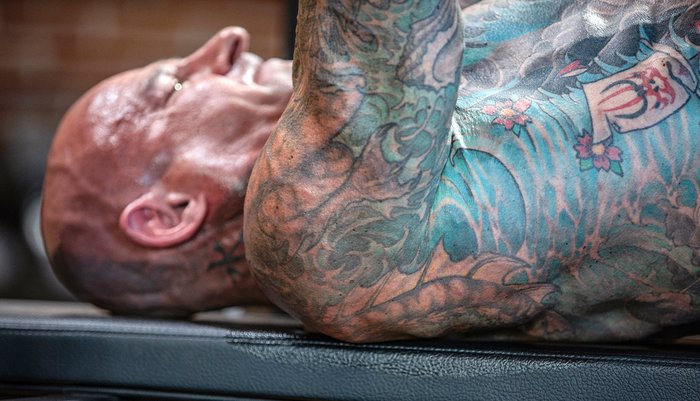
x
One technique cue is to imagine you're holding grapefruits in your armpits, and you don't want to let them fall to the floor. This visualization will help you keep your shoulders in the proper position and will also cue you to keep your elbows in instead of flared out. Flaring opens you up to potential rotator cuff issues, not to mention that elbows in, closer to your sides, is a more powerful pressing position. Your upper arms should be at somewhere between a 30-60-degree angle with your torso during the bench press.
Point of Contact Take-Home Tip: Keep your shoulder blades pulled back and together and your elbows tucked in throughout the movement.
4. Head
After the glutes, upper back, and shoulders, the last body part to contact the bench is the head. The message here is simple: Keep the back of your head touching the bench the entire time. Many people lift their head up, usually to watch the bar travel down to the chest, but this isn't great for the health of your spine, and it decreases your strength by as much as 10 percent.
Flexing your spine while handling a load is never a good idea, even when you're lying down on a bench and holding a weight in your arms. You risk pinching a nerve or even damaging a disc, which is a major contributor to lifters having neck surgery.
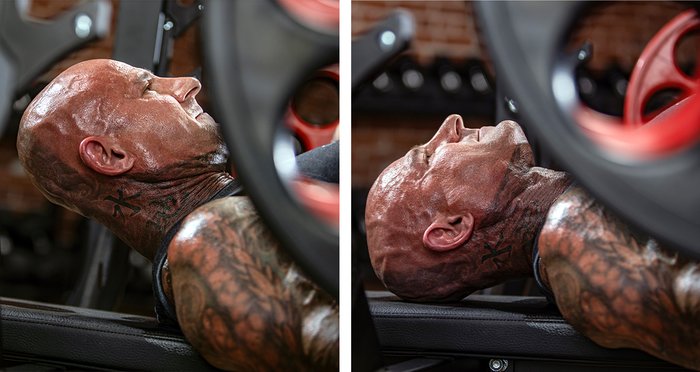
So don't try to keep an eye on the bar as it goes down to your chest. If anything, push your head back into the bench a bit.
Point of Contact Take-Home Tip: Keep the back of your head in contact with the bench at all times.
5. Hands
The last contact point is also the most controversial. Your hands are what physically connect you to the bar, and the type of grip you take and the width of your hands on the bar are hugely important to both maximizing power and strength and keeping the lift safe.
First off, I'm a big proponent of using an open grip, where the thumbs are not wrapped around the bar but on the same side of it as your fingers. I like the open grip because of the force transfer it provides, but be sure that you're using it in a power rack with safeties and even a spotter.
If you use a closed grip, with your thumb wrapped around the bar, the bar naturally sits farther up in your palm and your wrist is extended to a greater degree. This doesn't make for a very strong transfer of force because the load has to go through that extended wrist before moving up the forearm.
If you use an open grip, however, the bar can sit higher up on the palm, that much closer to the forearm, creating a more direct transfer of force. The bar is virtually right in line with the forearm, minimizing wrist involvement. That's a much stronger position.
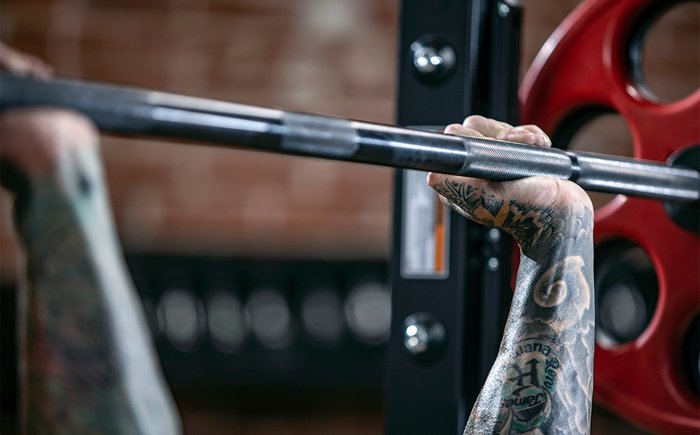
Is an open grip more dangerous than a closed grip? Yes. With the thumb wrapped, the bar is less likely to slip off your hand and fall to your chest. As you get stronger and get used to the open grip, you'll find that you're able to keep the bar in place without issue. Start light and build your way up.
The other debacle with hand placement on the bench press deals with grip width. Opinions differ on this, but I use a formula to determine the biacromial distance, or the best grip width for maximizing power and strength and reducing shoulder injury risk. If you go too wide, it will flare your elbows out, and you don't want that.
Here's how it works:
You have protruding bumps on either side of your shoulders called the acromion processes. The distance between these bumps is your biacromial distance. Mine, for example, is 14 inches.
Take the biacromial distance and multiple it by 1.5, and that's your ideal bench press grip width. In my case, it's 21 inches. So, when I do the bench press, that's how far apart I place my hands. From the middle of the bar, I'll measure out 10.5 inches on each side, and that's where my thumbs will hit.
Point of Contact Take-Home Tip: Use an open grip and the biacromial distance for hand spacing to maximize bench press strength.
Want unlimited access to all of my programs and an endless supply of content like this? Visit JimStoppani.com and become a member.




